Abstract
The capacity of gastrocnemius and quadriceps muscles to oxidize palmitate, oleate, linoleate, palmityl CoA, and palmityl carnitine doubled in rats subjected to a program of treadmill running. The rate of palmitate oxdation by whole homogenates of, or the mitochondrial fraction from, leg muscles was twice as great per gram wet weight of muscle in the trained as in the sedentary animals over a wide range (0.125-1.5 mM) of palmitate concentrations.
The levels of activity of carnitine palmityltransferase, palmityl CoA dehydrogenase, and mitochondrial ATP-dependent palmityl CoA synthetase expressed per gram of muscle doubled in gastrocnemius and quadriceps muscles in response to the running program. The protein content of the mitochondrial fraction from these muscles was increased approximately 60%.
Full text
PDF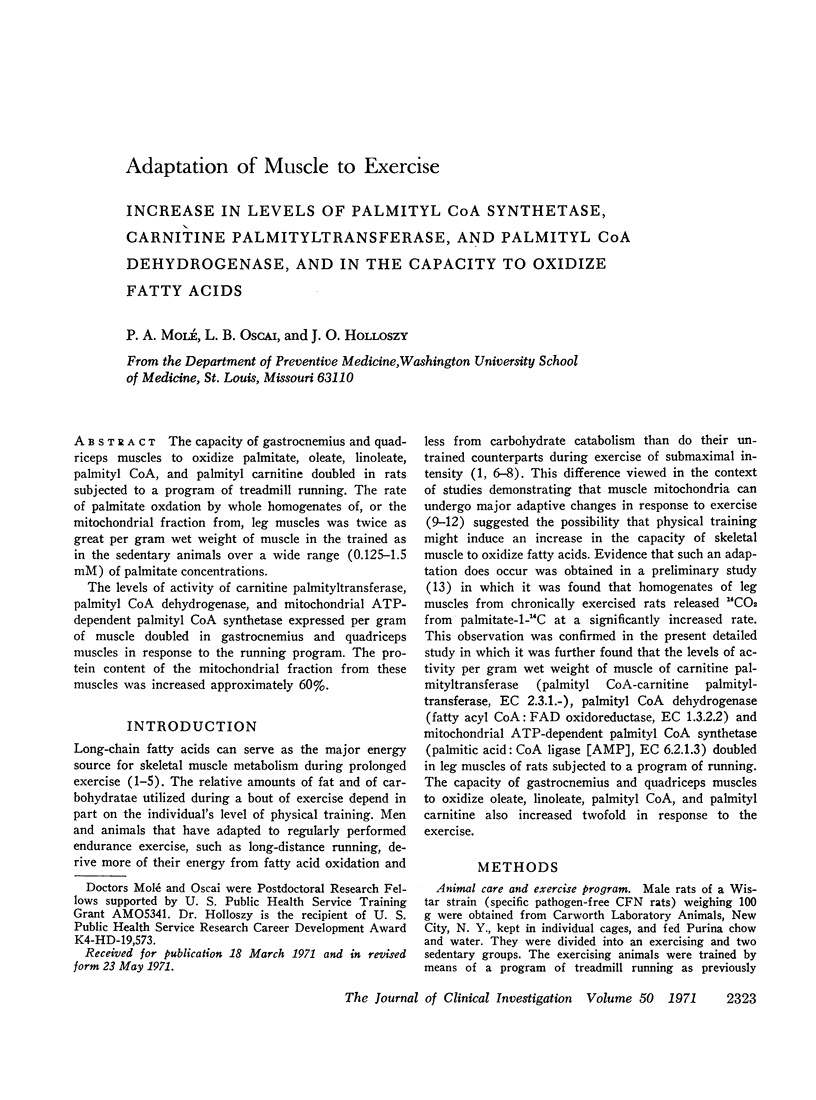


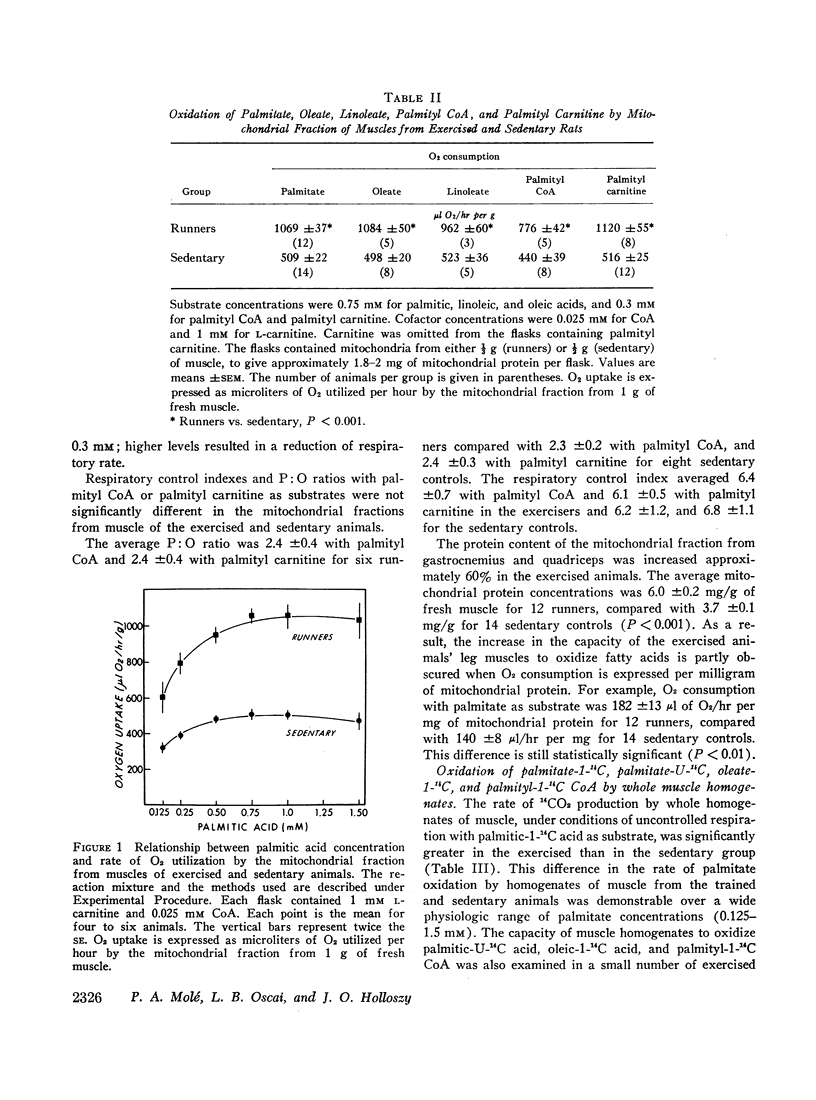

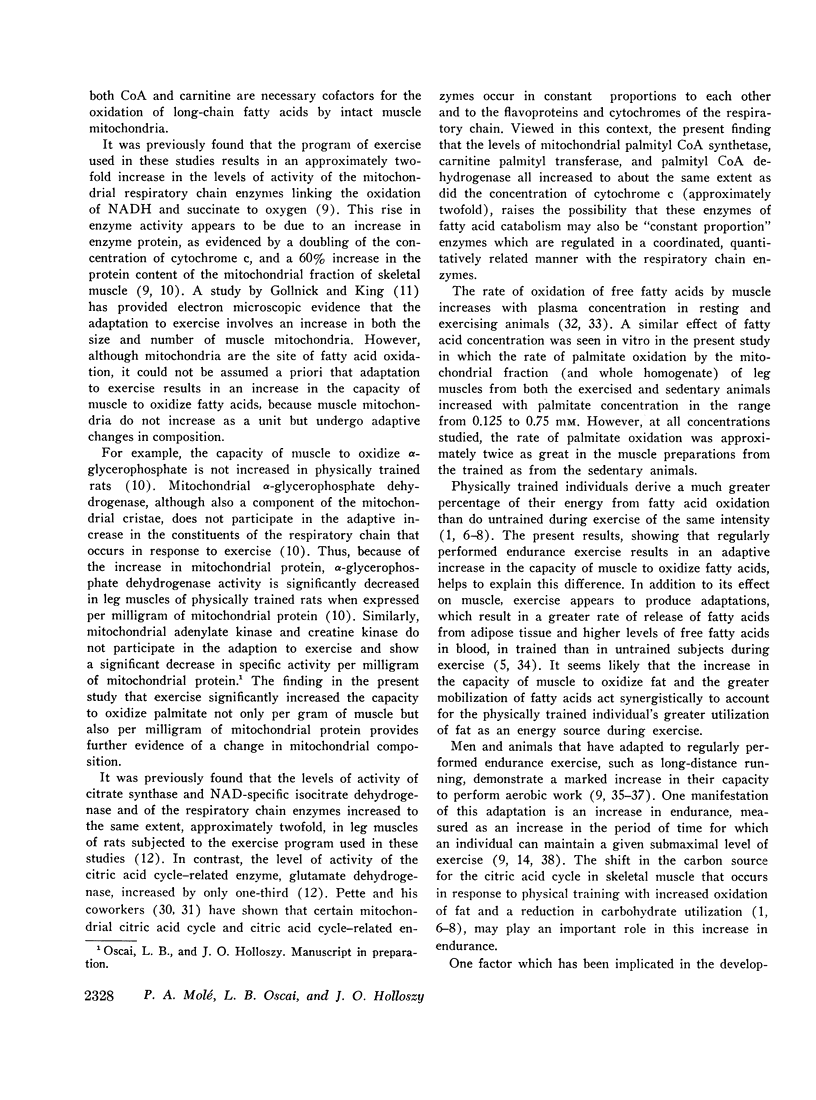
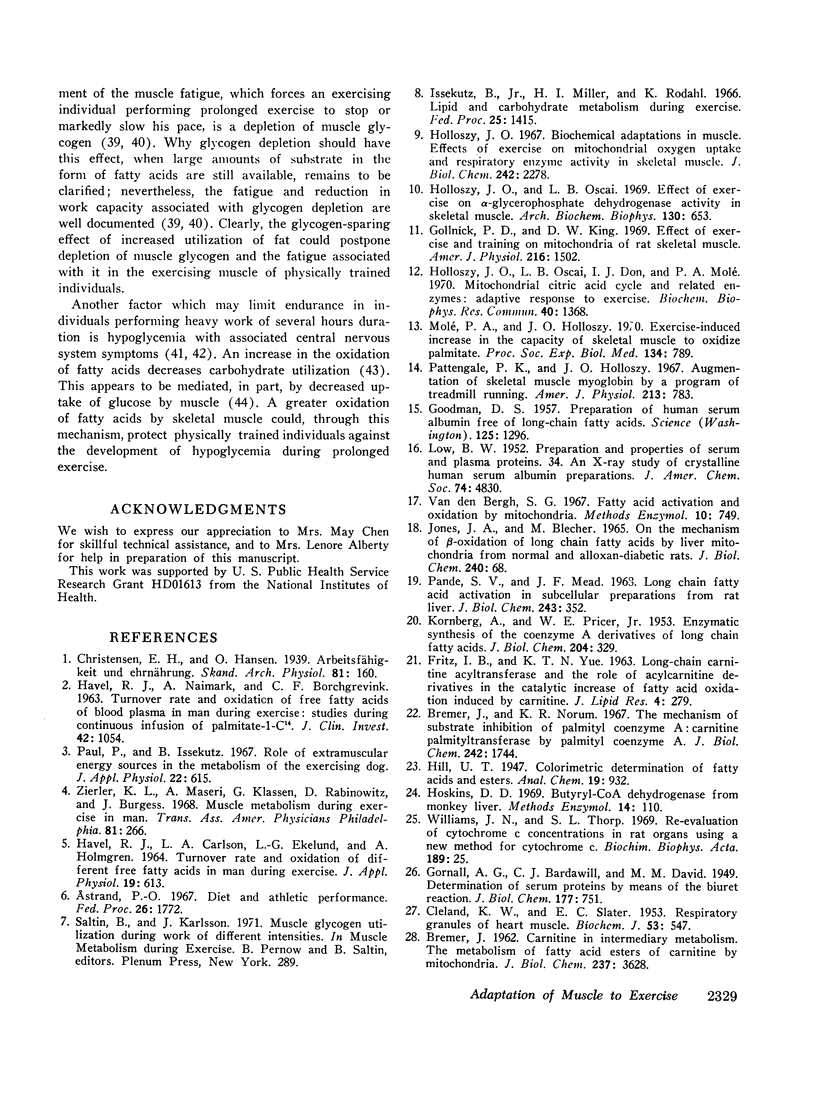
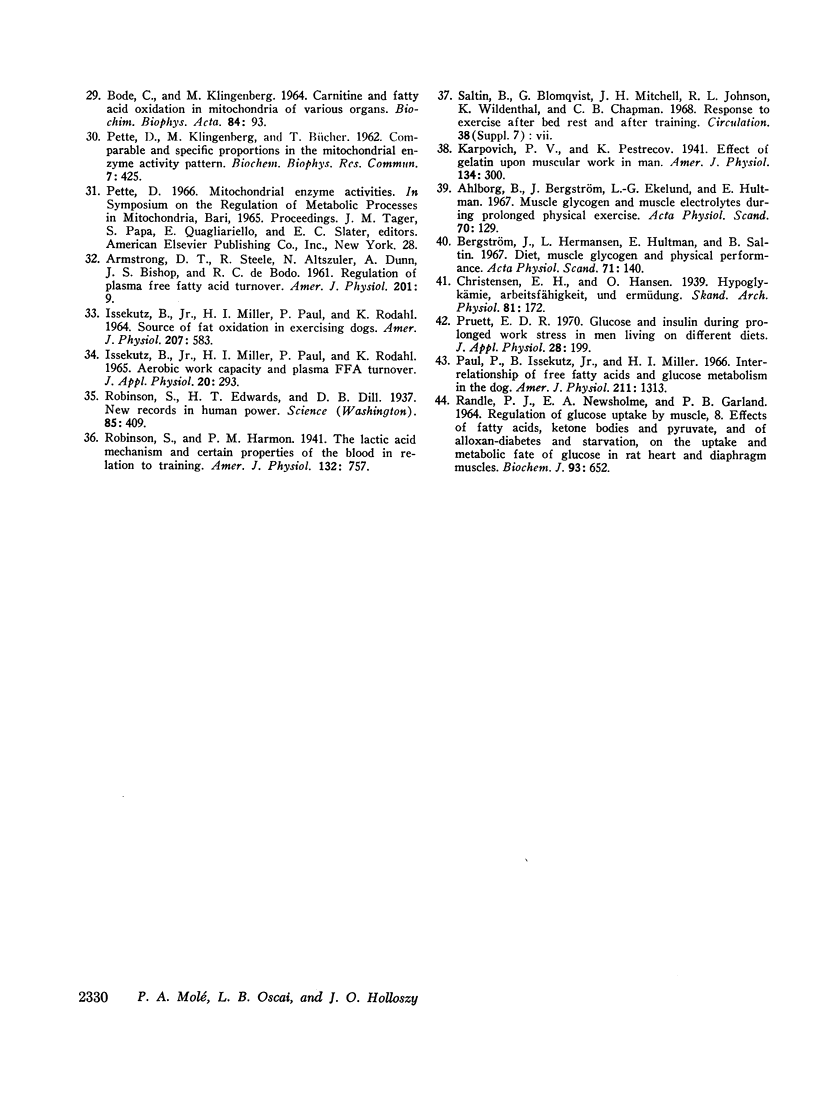
Selected References
These references are in PubMed. This may not be the complete list of references from this article.
- ARMSTRONG D. T., STEELE R., ALTSZULER N., DUNN A., BISHOP J. S., DE BODO R. C. Regulation of plasma free fatty acid turnover. Am J Physiol. 1961 Jul;201:9–15. doi: 10.1152/ajplegacy.1961.201.1.9. [DOI] [PubMed] [Google Scholar]
- Astrand P. O. Diet and athletic performance. Fed Proc. 1967 Nov-Dec;26(6):1772–1777. [PubMed] [Google Scholar]
- BODE C., KLINGENBERG M. CARNITINE AND FATTY ACID OXIDATION IN MITOCHONDRIA OF VARIOUS ORGANS. Biochim Biophys Acta. 1964 Feb 24;84:93–95. doi: 10.1016/0926-6542(64)90105-2. [DOI] [PubMed] [Google Scholar]
- BREMER J. Carnitine in intermediary metabolism. The metabolism of fatty acid esters of carnitine by mitochondria. J Biol Chem. 1962 Dec;237:3628–3632. [PubMed] [Google Scholar]
- Bergström J., Hermansen L., Hultman E., Saltin B. Diet, muscle glycogen and physical performance. Acta Physiol Scand. 1967 Oct-Nov;71(2):140–150. doi: 10.1111/j.1748-1716.1967.tb03720.x. [DOI] [PubMed] [Google Scholar]
- Bremer J., Norum K. R. The mechanism of substrate inhibition of palmityl coenzyme A:carnitine palmityltransferase by palmityl coenzyme A. J Biol Chem. 1967 Apr 25;242(8):1744–1748. [PubMed] [Google Scholar]
- CLELAND K. W., SLATER E. C. Respiratory granules of heart muscle. Biochem J. 1953 Mar;53(4):547–556. doi: 10.1042/bj0530547. [DOI] [PMC free article] [PubMed] [Google Scholar]
- FRITZ I. B., YUE K. T. LONG-CHAIN CARNITINE ACYLTRANSFERASE AND THE ROLE OF ACYLCARNITINE DERIVATIVES IN THE CATALYTIC INCREASE OF FATTY ACID OXIDATION INDUCED BY CARNITINE. J Lipid Res. 1963 Jul;4:279–288. [PubMed] [Google Scholar]
- GOODMAN D. S. Preparation of human serum albumin free of long-chain fatty acids. Science. 1957 Jun 28;125(3261):1296–1297. doi: 10.1126/science.125.3261.1296. [DOI] [PubMed] [Google Scholar]
- Gollnick P. D., King D. W. Effect of exercise and training on mitochondria of rat skeletal muscle. Am J Physiol. 1969 Jun;216(6):1502–1509. doi: 10.1152/ajplegacy.1969.216.6.1502. [DOI] [PubMed] [Google Scholar]
- HAVEL R. J., CARLSON L. A., EKELUND L. G., HOLMGREN A. TURNOVER RATE AND OXIDATION OF DIFFERENT FREE FATTY ACIDS IN MAN DURING EXERCISE. J Appl Physiol. 1964 Jul;19:613–618. doi: 10.1152/jappl.1964.19.4.613. [DOI] [PubMed] [Google Scholar]
- HAVEL R. J., NAIMARK A., BORCHGREVINK C. F. Turnover rate and oxidation of free fatty acids of blood plasma in man during exercise: studies during continuous infusion of palmitate-1-C14. J Clin Invest. 1963 Jul;42:1054–1063. doi: 10.1172/JCI104791. [DOI] [PMC free article] [PubMed] [Google Scholar]
- Holloszy J. O. Biochemical adaptations in muscle. Effects of exercise on mitochondrial oxygen uptake and respiratory enzyme activity in skeletal muscle. J Biol Chem. 1967 May 10;242(9):2278–2282. [PubMed] [Google Scholar]
- Holloszy J. O., Oscai L. B., Don I. J., Molé P. A. Mitochondrial citric acid cycle and related enzymes: adaptive response to exercise. Biochem Biophys Res Commun. 1970 Sep 30;40(6):1368–1373. doi: 10.1016/0006-291x(70)90017-3. [DOI] [PubMed] [Google Scholar]
- Holloszy J. O., Oscai L. B. Effect of exercise on alpha-glycerophosphate dehydrogenase activity in skeletal muscle. Arch Biochem Biophys. 1969 Mar;130(1):653–656. doi: 10.1016/0003-9861(69)90083-6. [DOI] [PubMed] [Google Scholar]
- ISSEKUTZ B., Jr, MILLER H. I., PAUL P., RODAHL K. SOURCE OF FAT OXIDATION IN EXERCISING DOGS. Am J Physiol. 1964 Sep;207:583–589. doi: 10.1152/ajplegacy.1964.207.3.583. [DOI] [PubMed] [Google Scholar]
- Issekutz B., Jr, Miller H. I., Rodahl K. Lipid and carbohydrate metabolism during exercise. Fed Proc. 1966 Jul-Aug;25(4):1415–1420. [PubMed] [Google Scholar]
- JONES J. A., BLECHER M. ON THE MECHANISM OF BETA-OXIDATION OF LONG CHAIN FATTY ACIDS BY LIVER MITOCHONDRIA FROM NORMAL AND ALLOXAN-DIABETIC RATS. J Biol Chem. 1965 Jan;240:68–70. [PubMed] [Google Scholar]
- KORNBERG A., PRICER W. E., Jr Enzymatic synthesis of the coenzyme A derivatives of long chain fatty acids. J Biol Chem. 1953 Sep;204(1):329–343. [PubMed] [Google Scholar]
- PETTE D., KLINGENBERG M., BUECHER T. Comparable and specific proportions in the mitochondrial enzyme activity pattern. Biochem Biophys Res Commun. 1962 Jun 4;7:425–429. doi: 10.1016/0006-291x(62)90328-5. [DOI] [PubMed] [Google Scholar]
- Pande S. V., Mead J. F. Long chain fatty acid activation in subcellular preparations from rat liver. J Biol Chem. 1968 Jan 25;243(2):352–361. [PubMed] [Google Scholar]
- Pattengale P. K., Holloszy J. O. Augmentation of skeletal muscle myoglobin by a program of treadmill running. Am J Physiol. 1967 Sep;213(3):783–785. doi: 10.1152/ajplegacy.1967.213.3.783. [DOI] [PubMed] [Google Scholar]
- Paul P., Issekutz B., Jr, Miller H. I. Interrelationship of free fatty acids and glucose metabolism in the dog. Am J Physiol. 1966 Dec;211(6):1313–1320. doi: 10.1152/ajplegacy.1966.211.6.1313. [DOI] [PubMed] [Google Scholar]
- Paul P., Issekutz B., Jr Role of extramuscular energy sources in the metabolism of the exercising dog. J Appl Physiol. 1967 Apr;22(4):615–622. doi: 10.1152/jappl.1967.22.4.615. [DOI] [PubMed] [Google Scholar]
- Randle P. J., Newsholme E. A., Garland P. B. Regulation of glucose uptake by muscle. 8. Effects of fatty acids, ketone bodies and pyruvate, and of alloxan-diabetes and starvation, on the uptake and metabolic fate of glucose in rat heart and diaphragm muscles. Biochem J. 1964 Dec;93(3):652–665. doi: 10.1042/bj0930652. [DOI] [PMC free article] [PubMed] [Google Scholar]
- Robinson S., Edwards H. T., Dill D. B. NEW RECORDS IN HUMAN POWER. Science. 1937 Apr 23;85(2208):409–410. doi: 10.1126/science.85.2208.409. [DOI] [PubMed] [Google Scholar]
- Williams J. N., Jr, Thorp S. L. Re-evaluation of cytochrome c concentrations in rat organs using a new method for cytochrome c. Biochim Biophys Acta. 1969 Sep 16;189(1):25–28. doi: 10.1016/0005-2728(69)90220-5. [DOI] [PubMed] [Google Scholar]
- Zierler K. L., Maseri A., Klassen G., Rabinowitz D., Burgess J. Muscle metabolism during exercise in man. Trans Assoc Am Physicians. 1968;81:266–273. [PubMed] [Google Scholar]


